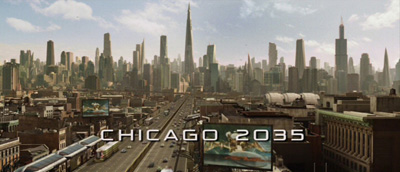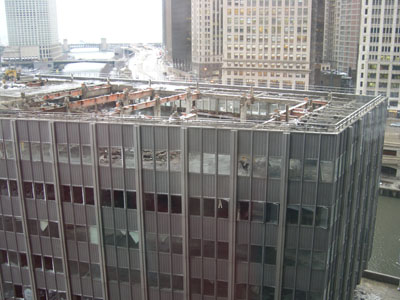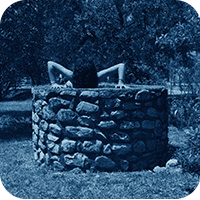A CTA Map for 2055
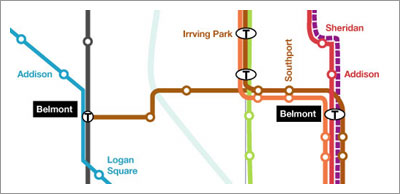
Proposed Roscoe Village Brown Line spur that would make my life approximately 1000 times easier
Craig Berman, author of the wonderful Fueled by Coffee blog, has a great piece up at Gaper’s Block. Using the CTA’s proposed Circle Line as a starting point, he meticulously outlines a subway plan for the future of Chicago.
The CTA needs to form a mass transit network — as opposed to the current radial commuter rail. Right now, all lines lead to the Loop in the morning and back out in the afternoon — these lines don’t take into account that a lot of living happens outside of the skyscrapers of the Loop. What happens when I want to get from Bucktown to Wrigleyville? Andersonville to the West Loop? Hyde Park to Pilsen? Little Village to Logan Square? These rides are a pain in the ass — they’re slow, indirect, and require multiple bus transfers. Why can’t you move from the North Side to the northWest Side without going downtown first? I want answers, dammit!
Amen, brother. Where do I sign up to help digging?
See also: Art of the subway
Subcontinental divide
A word problem for you, dear readers.
You are on Harlem Avenue in Chicago driving south near Ogden Avenue going approximately 35 MPH. You’re sipping (rather enjoying) a piping-hot venti half-decaf no-fat latte with a shot of sugar-free hazelnut when a billboard for a rock station depicting a sweaty lady in a tank top grabs your eye. You fail to see the car in front of you slow to make a left turn onto 39th street. You look up just in time, slam your brakes, crushing your latte between your sternum and the steering column, spilling hot liquid (no fat, though!) into your lap which causes you to recoil and inexplicably hit the gas again. As you look up again (crotch still ablaze) you swerve the car right (west) to avoid hitting the damn car that still has not turned left. You nail the curb, pop up briefly, and land squarely on a fire hydrant. Which explodes in two directions (roughly straight up and west-southwest) spewing a great geyser of water onto Harlem Avenue at a rate of approximately four liters per second.
Will the water that is dumping into the road end up in Lake Michigan or in the Gulf of Mexico?
A few tracks from the iTunes store for whomever gets this right first.
(Thanks for this one, Dad!)
UPDATE: Here’s the solution.
That was fun, now everybody start sweeping
Though there’s still a corner of the building sticking up ominously from the rubble (bearing an unfortunate similarity to the shards that remained of the WTC after 9/11), the Sun-Times building is effectively no more. Mostly the activity outside my window is just cleanup of the mess. And ripping a building down does make one hell of a mess. I don’t need to pull the shades on the windows in the office there is such an impenetrable layer of filth on them.
My sons came with me to see the heavy machinery this weekend. Predictably, they could not be pulled away. Not only was there blow-torching, aggressive hole-digging, and manly rubble-scooping going on, but they were constructing a mighty, towering crane which to me means that construction is soon to start. I swear we saw them dig out an old train car undercarriage from the muck. (Might make sense. Train tracks used to run along the north edge of the river.)
Here’s a video timelapse of the deconstruction through Feb. 11. Is it possible that I actually miss the jaw-jarring din of the last few weeks?
Passings

The artist Ed Paschke died in his sleep last Thanksgiving. I was introduced to his work in 2000 when some IBM colleagues suggested that he would make a good speaker at the opening of our new space. It was an interesting choice. Paschke was an avowed technophobe. He was fascinated with holography, though, and open to collaborating with computer designers. He agreed to speak at our opening. I remember him standing in a forest of displays on the dais, more avuncular than bohemian, a little bewildered at the sight of it all. He lent us one of his most stunning electronic pieces for a few months. It hung in our space and I secretly hoped his studio would forget that they had placed it there. They didn’t.
A memorial tribute exhibition to Paschke opened on Friday at the Maya Polsky Gallery. It runs until March 12.
In other news, another famous Chicagoan has left the building. Don’t let the door hit you on the way out, Sammy! (The security cameras are watching.)
Tipping point
What’s the worst single disaster in terms of the loss of human life in the history of Chicago? You might say the Chicago Fire or the Iroquois Theater Fire. You’d be wrong. This summer marks the 80th anniversary of the Eastland Disaster on the Chicago River when an excursion steamer packed mostly with employees from a single company bound for a beach outing simply tipped over — crushing, trapping, or drowning 884 people in the sewage-infused river.

There’s an historic plaque a few blocks west of my office directly across the river commemorating the event, but, other than people on Haunted Chicago bus tours, few know of the tragedy. So I was pleased to see a new book on the topic. Pleased to see, that is; not so pleased to read. Jay Bonansinga’s The Sinking of the Eastland tells the tale in the narrative or “creative” non-fiction style so popular recently, but it falls flat and, at times, causes you to smirk at the overwrought pathos. And, you know, you shouldn’t be smirking at an event that wiped out 22 entire families. The problem, I think, is that Bonansinga’s story is caught — squeezed — between two mammoth master narratives. The first is the story of the Titanic (which sunk only three years before the Eastland) and all the vice-like purchase that tale has on the popular imagination these days. (Thank you very much, Leo.) The second is Erik Lawson’s The Devil in the White City, the story of the 1893 World’s Columbian Exposition which, for many readers (at least in Chicago), single-handedly defines the genre of narrative non-fiction. The Sinking of the Eastland just tries too hard to hard to make you weepy. This might be a reaction to the perplexing absence of the sinking from Chicago’s collective memory. And I suppose I don’t blame him for that. It really is odd how entire cities forget things.
Bonansinga does highlight an interesting theory on why the Eastland capsized. Indignation over the lifeboat situation on the Titantic had reached such a level in the years after that catastrophe that ships around the world were outfitted with far more lifeboats than they were designed to carry. Mostly the lifeboats hung from the top decks, dangerously skewing ships’ centers of gravity. It almost defies belief that so many people could die on a boat still tied to the wharf, but this lifeboat top-heaviness, coupled with a too-crowded ship and improper ballasting, was all it took to pitch the Eastland into the drink.
Mine!
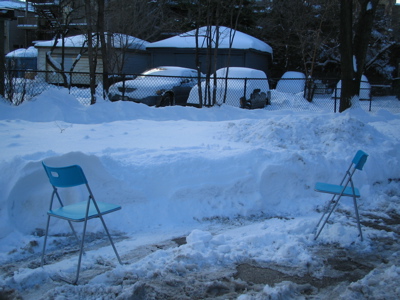
A few weeks ago we got quite a load of snow, but I was shocked to see not a single piece of household detritus placed in the street to claim a parking spot that had been carefully shovelled out. You see, the thinking here normally holds that if you go to the effort to excavate your car you shouldn’t have to cede the spot to some lazy schmuck when you drive off. This “tradition” of essentially claiming a property right for what is not yours is openly condoned by City Hall and often derided by suburbanites who love to highlight the irony of such un-neighborly conduct by the very citydwellers who bemoan the lack of sidewalk-centric community bonds in the suburbs.
Well, my worry was for nothing. This weekend we got an even bigger winter dumping (though not as big as what’s pounding the east coast) and, true to form, the crap is piling up in the street. Derelict couchs, two-by-fours, plastic lawn furniture — whatever can be tossed into the spot to prevent a would-be spot-stalker. There’d been some talk that gentrification was slowly killing this tradition, presumably because yuppies have garages and they like their streets not to look like the aftermath of a flea market. I’m happy to report that this does not seem to be the case. However, I will suspend final judgement on this trend until I see an altercation over a shovelled spot. (Certain brave drivers will actually move the impromptu barricades off the street to get a spot.) Only if the dispute ends in one neighbor deliberately icing another’s car with a hose will I consider the tradition to be thriving.
Parallel-o-gram
To the driver of Checker cab #5557:
Just a quick note of thanks for not killing my wife and son today as you hurriedly attemped to pass their parked car on Lincoln Ave. (Yes, I have two sons, but I’m rather fond of the blonde one you nearly mowed down.) I’m so relieved that you weren’t hurt and that you were able to get to your next passenger 4/1000th‘s of a second before you otherwise would have. Think of the potentially lost income!
Also, I wanted to say thanks for the legal lesson you gave my wife. True, it might have been more effectively delivered if you were not screaming and gesticulating threateningly at her, but I admit that I have no law training so I’m not totally qualified to comment on your rhetorical strategy. One correction, though. It is not actually illegal for doors on the driver’s side to be opened into traffic when parallel parked. However, a friendly police officer to whom my wife spoke did note that it was her responsibility to make sure that she was not blocking traffic in any way when opening the door. Can you believe she was actually trying to put our toddler son into his car seat from the same side of the car that it is installed on? I mean, that’s just lazy. She clearly should have climbed over the other car seat on the other side of the car and inserted said toddler long-distance style. Who cares if that’s a physical impossibility. That’s what sun-roofs are for, right?
So, I apologize for any inconvenience. As soon as I get home tonight I will reprimand my wife both for her ignorance of the law and for showing such vehicular effrontery to you and the entire taxi driving community in Chicago. Please know that if I am ever in your cab in the future — #5557, easy to remember — I will make certain that my feelings on this matter are made even more forcefully than this letter permits me. You have my word on that.
Sincerely,
John Tolva
PS – Given your legal acumen, we were wondering if you could outline the law’s position on stopping your cab in traffic to deliver a lecture on municipal parking regulations to a mom and her kid? Thanks!
Rendered Chicago
The city of Chicago envisioned by Alex Proyas in the movie I, Robot is set almost as many years in the future as I have been alive. Either I’m underestimating the last three decades of technological progress or Proyas is being too optimistic about how quickly his vision could be reality, but in either case the movie is an enjoyable one, teasing a pretty decent narrative out of a collection of loosely connected short stories and novels by Isaac Asimov. I especially enjoyed the film’s elaborate CG environments that create a clearly futuristic but also recognizable cityscape. (They had to, the movie was shot in Canada.) I’ve read that Proyas set the movie when and where he did because he liked the way the Chicago of today juxtaposes old and new architecture so comfortably and thoroughly. Of course, I agree, and for the most part the movie does a great job taking this trend into the future. I was intrigued by the choices the virtual urban planners made in removing and inserting new structures into the skyline. (And if you are too, you’ll want to visit the Art Institutes’s excellent 10 Visions exhibit.)
I’ve created a Flickr gallery of screenshots from almost all the scenes of Chicago in the movie. It is pretty clear where the designers placed the U.S. Robotics HQ building, but studying the images shows that they weren’t overly concerned with keeping it in the same place throughout the movie. A few things are clear from these shots:
- By 2035 Mayor Daley is dead because he isn’t in office because if he was he’d never allow a plaza like the one in the movie without a single flower bed or row of trees.
- The architect of 71 S. Wacker will be hired by USR to build their tower. His client’s only instruction: “make it taller.”
- Yes, we have sentient machines taking care of us, but was it worth it to give up recreational boating on the river?
- The L is way too silent and slinky. I can believe in robots with positronic brains, OK, but it simply defies belief that the CTA will ever get their act together for the effort required to replace the current clunky rolling stock (nor would I want them to, come to think of it).
These images raise a bunch of questions, some of which I’ve posed in the screenshot annotations and descriptions. Feel free to comment!
The mechanized ant hill outside my window
As if I didn’t have enough to distract me at work, the Sun-Times deconstruction has moved into high gear. It is impossible not to watch as the crews scurry around pummelling concrete to bits, blow-torching in half the very girders they’re standing on, and driving those cute miniature bulldozers to the very precipice of certain doom. These guys have now officially suffered through every element: wind (the bend in the river is one of the windiest points in the city), snow, rain, sneet, frizzle, and, yes, fire. I passed part of the hard-hatted crew at street level the other day and I felt like I was walking by celebrity. Reckless men of destruction, I salute you!
We’ve been taking snapshots of the work at 10-minute intervals since it started. Here’s a timelapse video of the work so far. (Thanks to Jack and Jeff for putting this together.)
More photos here.
Going, going, gone



The blogosphere likes to talk about toppling old media. Today, I saw it topple for real, with nary a blogger in sight. Beats my normal daydream-fodder cubicle vista.
I should have one hell of a view carved out for me when I return to work after the holidays. A temporary thanks to The Donald.
(Photo gallery here.)


